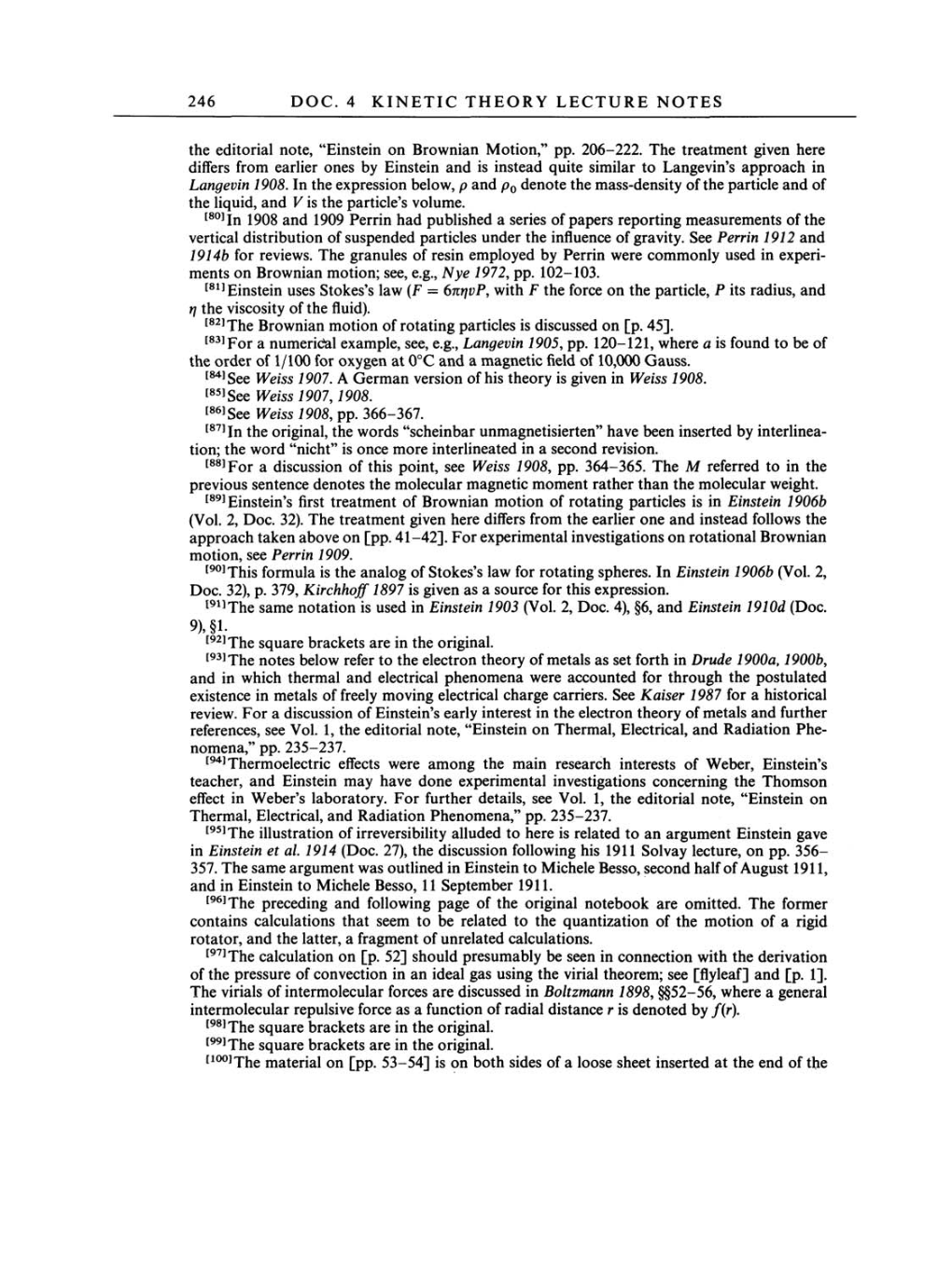246 DOC.
4
KINETIC THEORY LECTURE NOTES
the editorial
note,
"Einstein
on
Brownian
Motion," pp.
206-222. The
treatment
given
here
differs
from earlier
ones by
Einstein and
is
instead
quite
similar
to
Langevin's approach
in
Langevin
1908.
In the
expression
below,
p
and
p0
denote the
mass-density
of the
particle
and of
the
liquid,
and
V is
the
particle's
volume.
[80]In 1908
and
1909
Perrin had
published a
series
of
papers reporting
measurements
of the
vertical
distribution of
suspended particles
under the influence of
gravity. See
Perrin
1912
and
1914b
for
reviews.
The
granules
of resin
employed
by
Perrin
were commonly
used
in
experi-
ments
on
Brownian
motion;
see, e.g.,
Nye 1972, pp.
102-103.
[81]Einstein
uses
Stokes's
law
(F
=
6nrjvP,
with F the
force
on
the
particle,
P
its radius,
and
n
the
viscosity
of the
fluid).
[82]The
Brownian motion of
rotating particles is
discussed
on
[p. 45].
[83]For
a
numerical
example, see,
e.g., Langevin
1905, pp.
120-121,
where
a
is
found
to
be of
the
order of
1/100
for
oxygen
at
0°C and
a
magnetic
field of
10,000
Gauss.
[84]See
Weiss 1907.
A
German version of
his
theory is
given
in Weiss 1908.
[85]See
Weiss
1907, 1908.
[86]See
Weiss
1908,
pp.
366-367.
[87]In the
original,
the words "scheinbar
unmagnetisierten"
have been inserted
by
interlinea-
tion;
the
word "nicht"
is
once
more
interlineated
in
a
second revision.
[88]For
a
discussion of this
point,
see
Weiss
1908, pp.
364-365. The M referred
to in
the
previous
sentence
denotes the molecular
magnetic
moment
rather than the molecular
weight.
[89]Einstein's
first treatment
of Brownian motion of
rotating particles
is in
Einstein
1906b
(Vol.
2,
Doc.
32).
The
treatment
given
here
differs
from the earlier
one
and instead
follows
the
approach
taken above
on
[pp.
41-42].
For
experimental investigations
on
rotational Brownian
motion,
see
Perrin
1909.
[90]This
formula
is
the
analog
of Stokes's
law
for
rotating spheres.
In Einstein
1906b
(Vol.
2,
Doc.
32), p.
379, Kirchhoff
1897 is
given
as
a source
for this
expression.
[91]The
same
notation
is
used
in
Einstein
1903
(Vol.
2,
Doc.
4), §6,
and Einstein
1910d
(Doc.
9),§1.
[92]The
square
brackets
are
in
the
original.
[93]The
notes
below
refer to
the electron
theory
of metals
as
set
forth
in
Drude
1900a, 1900b,
and
in
which thermal and electrical
phenomena were
accounted for
through
the
postulated
existence
in
metals of
freely
moving
electrical
charge
carriers.
See
Kaiser
1987
for
a
historical
review.
For
a
discussion of Einstein's
early
interest
in
the electron
theory
of metals
and
further
references, see
Vol.
1,
the editorial
note,
"Einstein
on
Thermal, Electrical,
and Radiation Phe-
nomena,"
pp.
235-237.
[94]Thermoelectric
effects
were
among
the main research interests of
Weber,
Einstein's
teacher,
and Einstein
may
have done
experimental investigations concerning
the
Thomson
effect in
Weber's
laboratory.
For further
details,
see
Vol.
1,
the
editorial
note,
"Einstein
on
Thermal, Electrical,
and Radiation
Phenomena,"
pp.
235-237.
[95]The
illustration of
irreversibility
alluded
to
here
is
related
to
an
argument
Einstein
gave
in
Einstein
et
al. 1914 (Doc.
27),
the discussion
following his
1911 Solvay
lecture,
on
pp.
356-
357.
The
same
argument
was
outlined
in
Einstein
to
Michele
Besso,
second half
of
August 1911,
and
in
Einstein
to
Michele
Besso, 11 September
1911.
[96]The
preceding
and
following page
of the
original
notebook
are
omitted. The former
contains calculations
that
seem
to be
related
to
the
quantization
of the motion of
a
rigid
rotator,
and the
latter,
a
fragment
of unrelated calculations.
[97]The
calculation
on
[p.
52]
should
presumably
be
seen
in
connection with the derivation
of the
pressure
of convection
in
an
ideal
gas using
the
virial theorem;
see [flyleaf]
and
[p.
1].
The virials of intermolecular
forces
are
discussed
in Boltzmann
1898, §§52-56,
where
a
general
intermolecular
repulsive
force
as a
function of radial distance
r
is
denoted
by f(r).
[98]The
square
brackets
are
in
the
original.
[99]The
square
brackets
are
in
the
original.
[100]The
material
on [pp.
53-54]
is
on
both sides of
a
loose sheet inserted
at
the end of the
